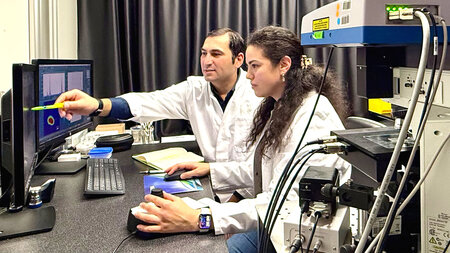Campus Areas Become Colourful Butterfly Meadows
Chemnitz University of Technology participates in the statewide campaign "Dollhouses Wanted - Blooming Meadows for Saxony's Butterflies”
-

The area in front of Thüringer Weg 9 will become a flowering meadow. Photo: Photo archive of the press office and cross-media editorial office -

Part of the area between the Turmbau and the parking lot will also be converted into a flowering meadow. Photo: Photo archive of the press office and cross-media communications
Butterflies and other insects have become rare everywhere, not only in Saxony. One reason is that in many places meadows with tall grass and countless flowers have disappeared. "In general, there has been an enormous decline in the number of forage plants for insects throughout Germany in recent years. This is caused, among other things, by constant land sealing, a standardization of the landscape and the associated impoverishment of meadows and arable land," says Prof. Dr. Marlen Gabriele Arnold, holder of the Professorship for Corporate Environmental Management and Sustainability and head of the "Sustainable Campus Development" working group at Chemnitz University of Technology. However, for the preservation of species and ecosystem services and the preservation of biodiversity, it is enormously important to create near-natural habitats for insects and small animals in settled areas. Chemnitz University of Technology wants to set impulses in this area in the future and is therefore participating in the project "Doll's houses wanted - blooming meadows for Saxony's butterflies" (link: http://www.schmetterlingswiesen.de/PagesSw/Content.aspx?id=2 ) from the Saxony State Foundation for Nature and the Environment and its partners. The aim of this participatory action is to design undeveloped areas as butterfly meadows.
Sustainable livelihood for insects and small animals
Three areas of Chemnitz University of Technology - behind the Turmbau and between Thüringer Weg 9 and 11 Campus C Reichenhainer Straße as well as behind building E04 on Campus E Erfenschlager Straße - will flourish starting this year. "A total of 2,200 square meters of lawn - the equivalent of the area of three soccer fields - were cleared of moss and mulch and then about 22 kilograms of seeds of native flowering plants were sown, which were provided free of charge by the project sponsor," reports Mandy Polster, a member of the "Sustainable Campus Development" working group. All the processes required for this were and are being carried out in close cooperation with the Department of Civil Engineering and Technology at Chemnitz University of Technology and the Staatbetrieb Sächsisches Immobilien- und Baumanagement (Saxony State Property and Construction Management).
"The type of mowing is also decisive for the establishment and preservation of the near-natural meadow areas at the university," explains Polster. In future, for example, the insect meadows are not to be completely mowed and lawnmowers which cut the plants without shredding them will be used. "It is also relevant that about a third of the managed meadow will remain standing - even if it does not necessarily look nice. Only then will insects and small animals have the opportunity to take refuge in the meadow that has been left standing, and any seeds that fall out can germinate again," says Polster. This helps butterflies to maintain their livelihood because eggs, caterpillars or pupae live on the stalks and leaves.
"A flowering meadow is not an English lawn"
"All project partners are aware that flowering or insect meadows require a change in public awareness and responsible behaviour - also at Chemnitz University of Technology. Therefore, we ask all members of the university to recognise the flowering meadows as ecosystem services and to take care that no rubbish dumps are created there," says Arnold. Likewise, using the fields as sunny meadows is not appropriate. "The fact is: a flowering meadow is not an English lawn. It is more like a small nature reserve and therefore requires careful treatment," explains the professor. Participation in the Saxony-wide campaign at Chemnitz University of Technology ensures more colourful and lively areas and is a future-proof component of the university's sustainability strategy. "At the same time, in the final year of the UN Decade of Biodiversity (link: https://www.undekade-biologischevielfalt.de/home-english/), Chemnitz University of Technology is sending a small but important signal on this topic," said Arnold. "Every commitment counts and strengthens the preservation of ecosystem services."
Background: Project "Dollhouses Wanted - Blooming Meadows for Saxony's Butterflies"
The project "Dollhouses Wanted - Blooming Meadows for Saxony's Butterflies" (link: http://www.schmetterlingswiesen.de/PagesSw/Content.aspx?id=2 ) is a Saxony-wide participatory action. The project, which was launched in 2015, is already having an effect: the number of meadows reported by towns and local authorities, housing cooperatives, regional project partners and private stakeholders is constantly increasing. Today, more than 400 meadows (link: https://www.schmetterlingswiesen.de/PagesSw/Default.aspx?id=1860 ) are managed in such a way that butterflies and insects can flourish again. Cooperation partners are the Saxon State Foundation for Nature and the Environment, the Senckenberg Museum of Zoology Dresden, the Nature and Biodiversity Conservation Union of Germany (NABU), the State Association of Saxony, the Saxon State Board of Trustees for Rural Areas and the German Association for Landscape Conservation. The project is supported by the Nature Conservation Fund of the Saxon State Foundation for Nature and the Environment from special-purpose proceeds of the Glücksspirale lottery.
Contact us: Prof. Dr. Marlen Arnold, telephone 0371 531-38070 (secretary), e-mail nachhaltigkeit@wirtschaft.tu-chemnitz.de, and Mandy Polster, telephone 0371 531-31801, e-mail mandy.polster@physik.tu-chemnitz.de
(Author: Mario Steinebach / Translation: Chelsea Burris)
Mario Steinebach
13.05.2020




